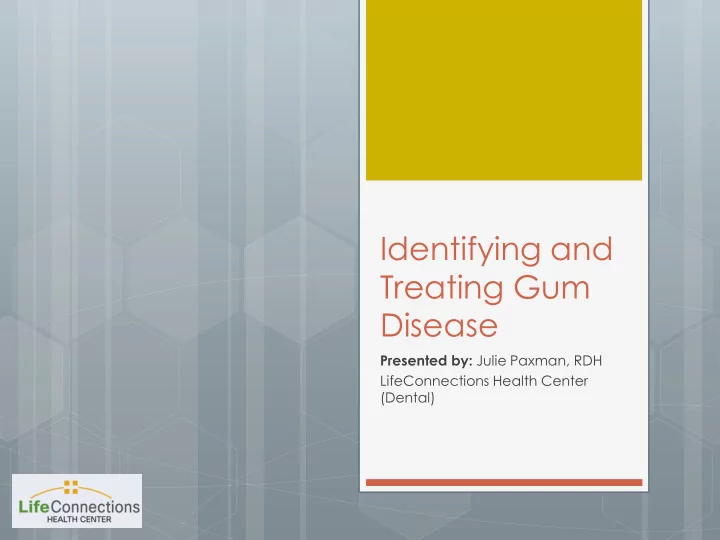

Identifying and Treating Gum Disease Presented by: Julie Paxman, RDH LifeConnections Health Center (Dental)
Julie Paxman, RDH LifeConnections Health Center (Dental) Graduate from Carrington College California – San Jose(A.S. Dental Hygiene, Honors) 2007-2008. Areas of expertise include providing prophylaxis (cleanings), periodontal maintenance, scaling and root planning, and adjunctive treatment procedures such as laser therapy and anti-microbial medicaments. My goal is to provide exceptional preventative dental care with a smile and cheerful disposition in order to help patients feel comfortable and gain the knowledge to keep their smile for a lifetime.
What is Gum Disease? Gum disease is an infection of the tissues that surround and support your teeth. It is a major cause of tooth loss in adults. Because gum disease is usually painless , you may not know you have it. Also referred to as periodontal disease , gum disease is caused by plaque, the sticky film of bacteria that is constantly forming on our teeth.
Here are some warning signs that can signal a problem: Gums that bleed easily Red, swollen, tender gums Gums that have pulled away from the teeth Persistent bad breath or bad taste Permanent teeth that are loose or separating Any change in the way your teeth fit together when you bite Any change in the fit of partial dentures
Some factors increase the risk of developing gum disease: Poor oral hygiene Smoking or chewing tobacco Genetics Crooked teeth that are hard to keep clean Pregnancy Diabetes Medications, including steroids, certain types of anti-epilepsy drugs, cancer therapy drugs, some calcium channel blockers and oral contraceptives
Early Stages of Gum Disease The early stage of gum disease is called gingivitis . If you have gingivitis, your gums may become red, swollen and bleed easily. At this stage, the disease is still reversible and can usually be eliminated by a professional cleaning at our dental office, followed by daily brushing and flossing.
Advanced Stages of Gum Disease Advanced gum disease is called periodontitis . Chronic periodontitis affects 47.2% of adults over 30 in the United States. It can lead to the loss of tissue and bone that support the teeth and it may become more severe over time. If it does, your teeth will feel loose and start moving around in your mouth. This is the most common form of periodontitis in adults but can occur at any age. It usually gets worse slowly, but there can be periods of rapid progression.
Aggressive periodontitis Aggressive periodontitis is a highly destructive form of periodontal disease that occurs in patients who are otherwise healthy. Common features include rapid loss of tissue and bone and may occur in some areas of the mouth, or in the entire mouth.
What does the research say? Research between systemic diseases and periodontal diseases is ongoing. Studies now indicate that severe gum disease may be associated with several other health conditions such as heart and lung disease, Alzheimer’s, Diabetes or Stroke.
No Warning Signs It is possible to have gum disease and have no warning signs . That is one reason why regular dental checkups and periodontal examinations are very important. Treatment methods depend upon the type of disease and how far the condition has progressed.
You don’t have to lose your teeth! Good dental care at home is essential to help keep periodontal disease from becoming more serious or recurring. Remember: You don’t have to lose teeth to gum disease. Brush your teeth twice a day, clean between your teeth daily, eat a balanced diet, and schedule regular dental visits for a lifetime of healthy smiles.
LifeConnections Health Center We are here to help you with all your dental needs and to ensure you achieve and maintain a healthy long-lasting smile.
Thank you! Thank you! Let’s open the discussion now for any Q&A.
Recommend
More recommend